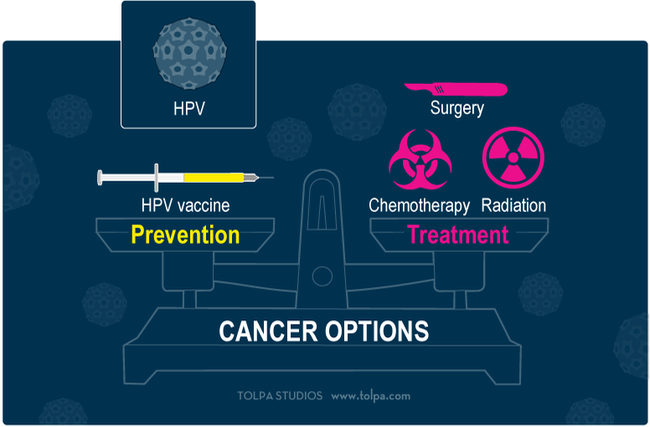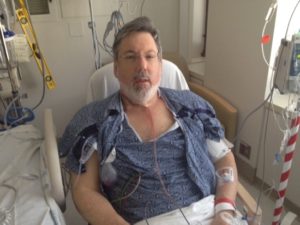The HPV Vaccine: Preventing Cancer Beats Curing It
By: Stewart Lyman, Ph.D., HPV-related Tonsil Cancer Survivor and HNCA ambassador
You don’t have to be an oncologist to know that fighting cancer is tough. Nearly 1.7 million Americans will be diagnosed with cancer this year, and about 600,000 will die from the disease. But here’s some good news: overall U.S. cancer deaths have been in a steep decline for over 25 years. Much of this reduction is tied to a decline in smoking, along with early detection of some cancers (e.g. colon), and more effective cancer therapies. While treatments for some particular types of cancer have advanced greatly, it’s still a disease no one wants to face. Fighting an opponent that you can never be really sure you’ve defeated challenges both the physical strength and mental fortitude of those who’ve been diagnosed. I know because I’ve been there.
Why put patients through painful surgeries, nausea-inducing chemo, and/or energy-sapping radiation treatments if you don’t have to? The majority of cancers, unfortunately, cannot presently be prevented, but some can. The primary example is cancers caused by human papillomaviruses (HPV). There are a large number of these sexually transmitted viruses (more than 150 types), but only a few strains (types 16 and 18) are responsible for the majority of HPV cancers.

These viruses are surprisingly widespread. According to the CDC, an estimated 79 million Americans have been infected by HPV. About fourteen million more Americans will be infected this year. That’s a huge number compared to new cases of other sexually transmitted diseases such as chlamydia (1.6 million), gonorrhea (469,000), or syphilis (about 30,000). The exact details of how transmission occur with HPV are still unclear. HPV is far and away the most common sexually transmitted infection, and about 80 percent of sexually active people will become infected with this virus sometime in their lives.
Most people successfully fight off the virus, but those who can’t are at risk of developing a number of different cancers. These include cervical, vaginal, and vulvar cancers in women, penile cancers in men, and anal and oral (tonsil, the base of the tongue, and back of the throat) cancers in both sexes.
Let’s focus on this last category – oral cancers (these belong to the broader category known as head and neck cancers). Despite the fact that cancer death rates have been dropping, the incidence of HPV positive oral cancers in the U.S. increased between 1988 and 2004 by a staggering 225 percent, and it’s still climbing. During that same time interval, the incidence of HPV negative oral cancers (that is, those NOT caused by the virus) dropped by 50 percent.
It’s expected that the annual number of HPV positive oral cancers will surpass the number of cervical cancers (which are mostly caused by HPV) sometime around 2020. About 7 percent of adult Americans have oral HPV infections, the majority of which will not lead to cancer. And for those who go on to develop cancer, the appearance of these tumors can take decades. Because these tumors are not painful early on, they’re most often diagnosed at stages 3 or 4 (i.e. after they’ve spread). Both sexes are not affected equally; four times as many men will develop HPV positive oral cancers than women. That ratio may increase to as many as seven times by 2030.

I was one of these men. I was diagnosed in 2016 with a malignant HPV 16 positive tonsil tumor. I’m sharing my story for one simple reason: I don’t want anyone else goes through what I did. I was lucky that my cancer was caught fairly early, and after treatment my prognosis going forward is good. My doctors, though, offer no guarantees. There are no screening tests yet to detect HPV positive oral cancers that can replicate the success of the Pap test used for detecting cervical cancer. Research to develop such a screening test is ongoing.
Vaccines to the Rescue
Preventing viral infections from taking hold can eliminate HPV as a cause of human cancers. Here’s the good news. The FDA has approved three different HPV vaccines since 2006: Gardasil, Gardasil 9 (which replaced Gardasil), and Ceravix. Development of these vaccines is truly a major health breakthrough. According to the National Cancer Institute, “All three vaccines prevent infections with HPV types 16 and 18, two high-risk HPVs that cause about 70% of cervical cancers and an even higher percentage of some of the other HPV-associated cancers. Gardasil also prevents infection with HPV types 6 and 11, which cause 90% of genital warts. Gardasil 9, prevents infection with the same four HPV types plus five additional high-risk HPV types (31, 33, 45, 52, and 58).”
Ceravix is no longer available in the U.S. market, making Gardasil 9 the current HPV vaccine of choice. It is given as a series of 2 or 3 shots and is highly effective in preventing infection with HPV. HPV vaccines have only been on the market for a decade, and they’ve already led to a large decrease in oral HPV infections. These vaccinations must be given before an individual is infected with HPV. Once you’ve been infected, the vaccine is useless at preventing disease. For this reason, the American Academy of Pediatrics (with its 60,000 members) recommends immunizing both girls AND boys starting at ages 11-12. Remember: if you can’t be infected, then you eliminate the possibility of being diagnosed one day with HPV-caused cancer. Be sure to ask your pediatrician about the vaccine.
If you’re not convinced yet that kids should get the vaccine, let me recast the cancer incidence data in another light. If most kids in the U.S. were vaccinated against HPV, it would, according to the National Cancer Institute, reduce the number of:
- Oral cancer cases (in both sexes) by 70 percent
- Anal cancer cases (in both sexes) by 95 percent
- Cervical cancer cases by 70 percent
- Vaginal cancer cases by 65 percent
- Vulvar cancer cases by 50 percent
- Penile cancer cases by 35 percent
Bottom line: the HPV vaccine can eliminate more than thirty thousand annual cancer cases! Get the picture? I wish I could have been vaccinated against the virus when I was a kid, but it wasn’t available back then. Parents nowadays should take advantage of this very effective weapon in the war on cancer.
Seems Like a No Brainer to Gets Kids Vaccinated
It should be. Vaccination is the same process that keeps kids from getting diseases such as mumps, measles, and chicken pox. However, only about half of girls and 38 percent of boys have currently been vaccinated in the U.S. The rest remain at risk of someday developing HPV induced cancers. The rates at which parents get their kids vaccinated varies greatly from state to state. The rates in the poorly vaccinating states are below the threshold of what is generally thought to be necessary to establish herd immunity against HPV, where uninfected people are generally protected from being infected by the vaccinated people around them.
Vaccination rates in the U.S. are way below some other countries. For example, the vaccination rate for girls in Rwanda is over 99 percent. Great success has also been seen with Australia’s vaccination program for girls. At the other end of the spectrum, the vaccination rate in Japan was nearly 70 percent in 2013, but now it’s close to zero. What caused the rate to plummet? It was caused by the widespread dissemination of pseudoscientific fraudulent studies as well as a disinformation campaign by vaccine opponents.
So Why Don’t Parents Get Their Kids Vaccinated?
There are many reasons, and they cut across all parts of the ideological spectrum. Many parents are simply uninformed about the dangers of HPV infections and don’t understand the need to vaccinate boys as well as girls. Others have picked up on the general climate of fear and misinformation about vaccines that pervades some communities. This leads them to take the path of least resistance and skip the vaccines. Many parents think they can’t get their kids immunized against HPV because they simply don’t have the money to pay for it. They haven’t heard about the Vaccines for Children program of the CDC. It provides vaccines at no cost for children whose families have an inability to pay.
Final Thoughts
I’ve been fighting against cancer for most of my adult life. Not personally, but professionally. I have a PhD in cancer research and spent most of my career working in the lab trying to develop innovative new drugs. Take it from me: cancer prevention is always preferable to cancer treatment. As I’ve transitioned from cancer researcher to cancer patient to cancer survivor, I vowed to make an effort to keep others from joining my club. Parents, please talk to your pediatrician and get both your boys and girls vaccinated against HPV. While you may never know for sure, you may very well save their lives.
To learn more, check out the extensive resources provided by the Centers for Disease Control (CDC). For more information specifically on the safety and efficacy of HPV vaccines, check out this page on the National Cancer Institute website. Parents – only you can prevent HPV induced cancers. Ask your pediatrician today about getting your kids vaccinated. For information on oral tumors caused by HPV, check out the numerous resources available from Head and Neck Cancer Alliance, the Oral Cancer Foundation, and Support for People with Oral and Head & Neck Cancer (SPOHNC). Finally, there’s a lot of false information about vaccines circulating on the Internet. Visit snopes.com to check out the veracity of rumors and claims that you read. A large percentage of these are likely to be false.
